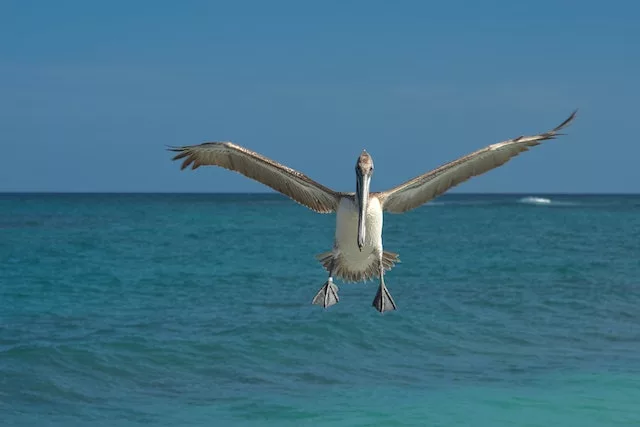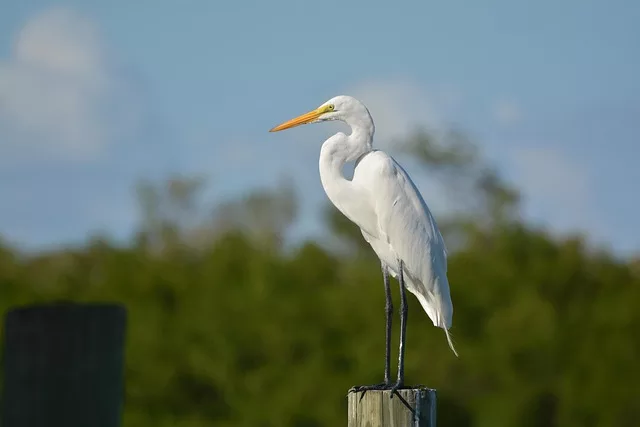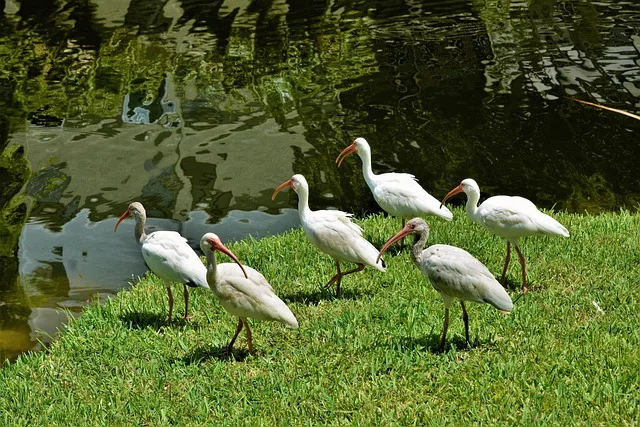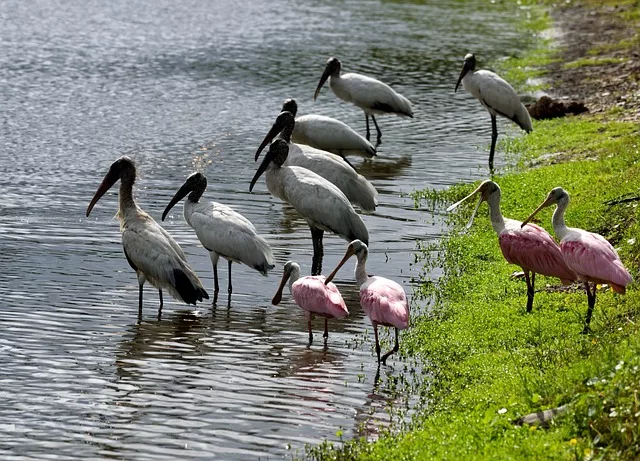If you go to the beach, go boating or kayaking, or even go for a walk in your neighborhood, there is a good chance that you will be able to spot several of Charleston’s shorebirds. Many beautiful and interesting birds are native to the area; and, for vacationers and transplants, spotting these birds can be a treat.
But, even if you’ve lived here all your life, it’s hard not to marvel at the natural environment that surrounds us. Charleston is truly a special place; and, while that is partially due to its human history and culture, it is also largely due to our surroundings and their native inhabitants.
Shorebirds vs. Seabirds: What’s the Difference?
Charleston has lots of different types of shorebirds. Each species has its own unique needs and preferences; and, as a result, while you’ll find some species of shorebirds in various areas around Charleston, there are also species that you will typically only see on Charleston’s inland waterways or along the coast.
While we’ve been using the term “shorebirds,” it is important to clarify that the correct term is actually “aquatic birds.” Shorebirds are a class of aquatic birds along with seabirds. Shorebirds, as their name suggests, live their life along the shore. They hunt for fish, shrimp, and crabs in Charleston’s marshes and inland waterways, or they hunt for food along the Atlantic shoreline. Seabirds, in contrast, live much of their life over the ocean. They may come inland to nest or seek protection during storms, but you are far more likely to see them in the sky than wading along the shore.
As the South Carolina Department of Natural Resources (SCDNR) further explains:
“Seabirds nest together in large groups on coastal islands and barrier beaches . . . . By nesting in large colonies, seabirds can keep an eye out for predators and can actively defend their nests from unwanted intruders.
“Shorebirds . . . prefer to inhabit mudflats or inter-tidal areas, and feed on invertebrates found in the soil. Most shorebirds are migratory, traveling long distances from their breeding grounds to their wintering areas.”
All About 10 Common Charleston Shorebirds (and Seabirds)
1. Brown Pelican
If you’ve been to the beach in Charleston, there’s a good chance that you’ve seen a brown pelican. Brown pelicans fly over the coast in formation, and they will congregate on the beach in areas without human crowds. They hunt for fish by looking from above, and you’ll often see pelicans dive (or, as is more often the case, crash) into the water to catch a meal.
Most of the pelican’s you’ll see in Charleston are brown pelicans, or eastern brown pelicans to be more precise. Notably, the National Audubon Society reports that while brown pelicans are now abundant, they were seriously endangered in the 1970s. As the National Audubon Society explains, “The current abundance of this species in the United States represents a success story for conservationists, who succeeded in halting the use of DDT and other persistent pesticides.”
Pelicans’ diet consists almost entirely of fish, although they will occasionally eat crustaceans on the shore. They nest in colonies, laying two to four eggs at a time. Brown pelicans can get up to about 4.5 feet in length, and their wingspan can surpass 6.5 feet.
Occasionally, you will also see American white pelicans along Charleston’s coastline. These pelicans are mostly white, with a yellow-orange beak and black feathers on the trailing side of their wings. According to The Cornell Lab of Ornithology, American white pelicans are among the largest birds in North America.

2. Great Blue Heron
Great blue herons are known for their distinguished, and striking, appearance. While they are easy to spot flying overhead or wading by a neighborhood pond, their coloring provides surprisingly good camouflage in the lowcountry’s marshlands. They are common in the Charleston area year-round, though you’re more likely to find them in the trees (look for a very large nest not too far from water) than along the shoreline during their nesting season.
Along with their impressive size (great blue herons can get up to 4.5 feet tall) and plumage, you can also recognize great blue herons by their distinctive “croak.” They will often croak when landing to signify their arrival, or croak when taking flight as a warning to others.
In addition to great blue herons, you may also spot a little blue heron or a tricolored heron along Charleston’s marshlands or inland waterways. Little blue herons are smaller than great blue herons and have more consistent coloring of a bluish-purple hue, while tricolored herons fall in the middle in terms of size and have bluish-grey wings and backs, a white underbelly, and a yellow beak and legs.

3. Great Egret
If you see a bird that is about the size of a great blue heron (though a bit more slender) that is white, you’ve most likely spotted a great egret.
We’d say that The Cornell Lab of Ornithology’s description of a great egret as an “elegant” and “dazzling” sight is pretty spot-on. Great egrets are majestic birds that use slow, powerful beats of their wings to glide through the air. Unlike great blue herons, you won’t have trouble spotting a great egret along the shoreline. While their bright white feathers provide camouflage against the bright summer sun, they stand out (and make for stunning photos) against the pluff mud and spartina grasses of Charleston’s coastal marshes.
According to the National Audubon Society, great egrets nearly went extinct in the 1800s, when they would be killed for their feathers. But, they now have a healthy population not only in Charleston, but along the entire Atlantic Coast all the way down to South America. Like great blue herons, they nest in trees high above the ground, and they typically lay three or four pale blue-green eggs at a time. Adults usually grow to about 3.5 feet tall.

4. Ibis
The first time you see an ibis, you might forget where you are. These tropical birds look like they belong in the Caribbean (and they live there, too), but they are at home right here in Charleston.
You’ll often see ibises in groups, whether probing the pluff mud for food or flying overhead. Adults are white with red legs, long, downturned red beaks, black tips on the underside of their wings—though you’ll occasionally spot a flock of pink scarlet ibises as well.
Like many shorebirds, ibises will eat just about anything they find. This includes everything from small crabs and fish to frogs and snails. They can lay up to five eggs at a time (which are pale blue-green to white with brown spots), and both parents help incubate and feed their hatchlings. While it is less common to hear an ibis, the National Audubon Society describes their calls as grunts and growls.

5. Roseate Spoonbill
The roseate spoonbill is another of Charleston’s more tropical-looking inhabitants. Roughly the size of a turkey, roseate spoonbills have pink and white feathers and long, spoon-shaped bills. You’ll most often see them wading along the edge of a marsh, frequently alongside great blue herons and great egrets.
Roseate spoonbills migrate to Charleston during their breeding season, which is in late spring and early summer. As a result, spotting a roseate spoonbill is a special treat. They nest in colonies and usually lay two or three eggs that are white with brown spots. The pink feathers on their wings and bodies become more vibrant as they get older, so if you spot a light-pink spoonbill it is most likely a juvenile. Their bills start to become spoon-shaped after about a week and are full-size after less than two months.
According to The Cornell Lab of Ornithology, the roseate spoonbill is the only species of spoonbill found in the Americas, and only one of six species of spoonbills in the world.

6. Sandpiper
Several species of sandpiper are native to the Charleston area. If you see a flock of small birds hunting together along the shore line or flying low over the edge of the water, there is a good chance that these are sandpipers. You can also recognize them by their distinctive “peep” sound, which you’ll often hear by the ocean.
It can be difficult to tell the different species of sandpipers apart. The Least Sandpiper has brown and black feathers with a white underbelly, and its head is fairly upright. The Western Sandpiper has similar coloring, but is more of a hunchback and has a slightly downturned head. The Spotted Sandpiper has more uniform coloring on its wings and back, but develops brown spots on its underbelly as an adult.

7. Snowy Egret
Snowy egrets are the author’s personal favorite of the Charleston shorebirds. They are much smaller than great egrets; and, while they share great egrets’ snow-white plumage, they have short black beaks and distinctive bright yellow feet.
Also similar to great egrets, the National Audubon Society reports that snowy egrets were hunted to near extinction in the 1800s. But, fortunately, today the snowy egret “is now more widespread and common than ever.”
Along with their yellow feet, snowy egrets also have distinctive wispy feathers on top of their heads, on their chests, and on the end of their tails. You’ll often see these standing up (or out) or blowing in the wind. Snowy egrets eat a typical Charleston shorebird diet, and lay anywhere from two to six pale blue-green eggs that hatch in 20 to 24 days.

8. Skimmer
Watching a skimmer feed often makes the author cringe. Skimmers get their name from their method of fishing. At high speed, skimmers swoop down to the water, open their beaks, and let the bottom skim through the water. While it seems like one unexpected stick or piece of floating spartina grass could send a skimmer tumbling, luckily it seems like they know what they’re doing.
Skimmers, also known as black skimmers, have black bodies and wings with white underbellies. But, their most distinctive feature is their beak. Bright orange by the skimmer’s head fading to black about half way down, the skimmer’s beak is larger than that of most birds of their size. The bottom half of the skimmer’s beak (or the lower mandible) is also longer than the top—adding to this Charleston shorebird’s unique appearance and helping it scoop up as much food as possible as it skims the water.
Black skimmers live in Charleston year-round. You’ll often see them on the beach, on sandbars, and on docks—in many cases in groups of 50 or more. The National Audubon Society describes their sound as a short barking note, and they lay three to seven eggs that hatch small all-white hatchlings.

9. Willet
The willet is one of the Charleston shorebirds that you are most likely to see at the beach. Significantly larger than sandpipers (but still only about a foot tall when fully grown), willets use their long, thin beaks to pipe the sand for food. You’ll find them right at the shoreline, often running up the beach as the waves come into stay out of the water.
These shorebirds look similar to another bird you’ll commonly find at the beach, the Greater Yellowlegs. As the latter’s name suggests, its main distinguishing features are its long yellow legs, which make up about half of adults’ overall height.
Willets sound somewhat similar to seagulls, though they have their own unique songs. They nest in colonies—including on the protected and uninhabited barrier islands of Deveaux Bank and Bird Key—laying four to five eggs in small nests that they build on the ground. Their plumage changes depending on whether they are breeding, from a pale gray when not breeding to speckled with brown and black spots during the breeding season.

10. Wood Stork
Wood storks look weird. There’s just no other way to put it. This isn’t a bad thing, but it’s true. While they have gorgeous white bodies accented by long black feathers on the underside of their wings, their heads can be hard to stomach. From the neck up, they are completely bald, and their skin looks more like it belongs on a reptile than a bird.
Sadly, the National Audubon Society reports that wood stork populations are in decline, largely due to destruction of habitat. Nonetheless, it is still possible to spot a wood stork in Charleston just about year-round—and, if you see one, you’ll know.
Wood storks can grow to about three feet tall, but their wingspan can get as large as 5.5 feet. When flying, they have a very distinctive shape, with their long beak sticking out in the front and their long legs sticking out behind. They typically nest in trees, building large nests where the females lay two to five eggs. Young wood storks typically take their first flight at about eight weeks old.

Of course, these are by no means all of the shorebirds and seabirds in Charleston—not even close. We’re just highlighting some of our favorites and some of the ones you are most likely to see in your Charleston neighborhood or on your vacation in Charleston. Now, next time you see one of these, you’ll have a few interesting facts to share.
Did you like this article? Subscribe to get notified of new articles via email.
